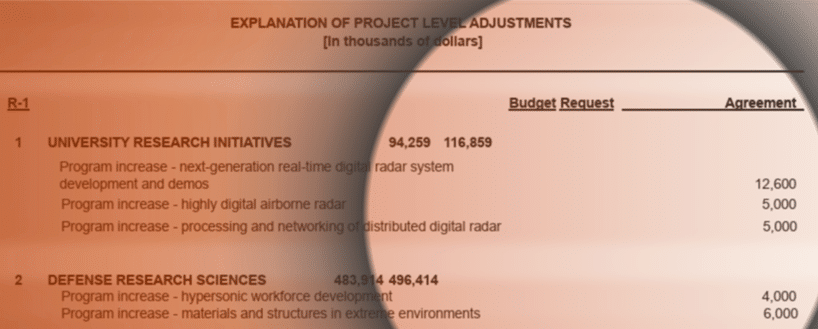Keen readers of our work at Taxpayers for Common Sense are well aware that the President’s Fiscal Year 2024 (FY24) budget request was recently released. We’ve been poring through the details and publishing our analysis ever since.
As we wrote last week, spending in the national security realm is at an all-time high. The request for “just” Pentagon spending is $842 billion, while overall National Defense spending (discretionary and mandatory) is a hair under $908 billion.
Let that sink in for a minute. We are now within shouting distance of spending a trillion dollars per year in our National Defense accounts. It’s enough to make fiscal conservatives like us feel a little dizzy just thinking about it.
But, as our followers also know, the President’s Budget Request (PBR) is never the final say on spending for the Pentagon account (Budget Function 051). This time last year the FY23 budget request for the Pentagon (versus all National Defense accounts) was $773 billion. When the budget lady finally sang, at the end of many negotiations between lawmakers and the Biden Administration, Congress appropriated $816 billion for the Pentagon, an increase of $43 billion over the request.
The song the budget lady always seems to be singing when it comes to Pentagon spending is Jackie Wilson’s hit song from the mid-1960s “Higher and Higher.” Those lyrics from 60, or so, years ago are prescient and could refer to lawmakers’ approach to defense spending:
“Your love keeps liftin’ me higher, than I’ve ever been lifted before. So, keep it up, quench my desire.
And I’ll be at your side forevermore!”
Like a broken record, lawmakers’ “love” for lavishing spending on the Pentagon keeps liftin’ that topline higher than it’s ever been lifted before. And, sadly, we don’t see common sense quenching that desire for more spending at the Department of Defense anytime soon.
For instance, the budget request for the most expensive procurement program in Pentagon history, the F-35 jet fighter, is $13.7 billion for 83 airframes. Lawmakers have a long history (“forevermore” one might say!) of adding money for even more aircraft and it’s highly likely the services’ so-called “Unfunded Priorities Lists” (UPLs) will ask for more. The only service UPL we’ve seen so far, the one from the Marine Corps, doesn’t ask for more aircraft, but does request an additional four “Engine/Lift Systems” for $122.4 million. (Speaking of engines for the F-35, don’t miss our comments in this recent Wall Street Journal article or our latest podcast which is partially on that very topic!)
What we’re still researching, and will add to our F-35 chart, is how many military construction (MILCON) projects are requested specifically to support the aircraft program, and at what cost. We’re perusing the MILCON charts now and will have that number soon.
Shipbuilding, another large driver of Pentagon procurement costs, is $32.8 billion for nine “battle force ships.” This significant investment will likely not satisfy the shipbuilding caucus on Capitol Hill, particularly given the Navy’s plan to retire twelve current ships. We all remember the bruising battle last year when the Navy tried to decommission some of the new Littoral Combat Ships (LCS), so brace yourselves for a repeat of that debate.
We hope Senate Armed Services Chair Jack Reed (D-RI) means what he said (and which was our “Quote of the Week” just last week): “Every department’s budget should be decided on its merits. Taxpayers should not have to pay for programs or systems that are wasteful or ineffective, and Congress must not shirk its responsibility to get rid of outdated platforms in favor of more effective new technologies.”
Amen, brother! Errr – Senator. Let’s start with that LCS.
Another factor driving the Pentagon budget “higher and higher” is the formation of the new Space Force, which is being cleaved from the Air Force and made its own institution. As we predicted during the last Administration, this is not going to come cheap. We broke down the Space Force budget request last year ($24.5 billion), and again this year ($30 billion). Each category of spending is up from last year’s request by 20-30 percent. Expect this budgetary ascent to continue as the Space Force takes off. Change ain’t cheap.
The documentation accompanying the Pentagon budget request runs to tens of thousands of pages. We’re keeping our green eyeshades on, digging through the documentation, and bringing you the most interesting nuggets.
Meanwhile, lawmakers’ love for Pentagon spending will keep lifting it “higher and higher!” And we’ll keep fighting for a commonsense approach to all federal spending.











Get Social